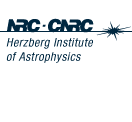
            
     
|
 |

History
Since its creation in April 1975 within the National Research Council of Canada (NRC), the NRC Herzberg Institute of Astrophysics (NRC-HIA) has been at the forefront of astrophysical developments in Canada. It has met its original goal to become "an international centre of excellence for research in astrophysics" (1975, JRASC 69, 144).
NRC-HIA was originally headquartered on the NRC campus at 100 Sussex Drive in Ottawa. In the early years, the emphasis was on astronomical research performed by HIA astronomers using NRC telescopes, such as the 1.8-m Plaskett optical telescope in Victoria, the 0.6-km synthesis radio telescope in Penticton, the 46-m radio telescope in Algonquin Park, and the 0.25-m solar optical telescope near Ottawa.
In the mid-1970s, NRC-HIA joined the 3.6-m Canada-France-Hawaii Telescope (CFHT) on Mauna Kea, Hawaii, with a 42.5% share. First light was achieved in 1979. In 1986, NRC-HIA established the Canadian Astronomy Data Centre (CADC) to create specialized software for astronomical data archiving, processing, calibrating, and interpretation. In 1986, the difficult financial situation made it impractical to resurface the Algonquin dish telescope and it was closed, along with the solar telescope near Ottawa. In 1987, NRC-HIA joined the 15-m James Clerk Maxwell (submillimetre radio) Telescope (JCMT) with a 25% share. In the 1990s, NRC-HIA joined the twin 8-m Gemini (optical) Observatory with a 15% share, with first light in 1999. In 1995, NRC-HIA Headquarters moved from Ottawa to the NRC campus in Victoria, BC at 5071 West Saanich Road.
In the last decade NRC-HIA has changed to play a more supportive role for university-based Canadian astronomers (our clients); designing, building and upgrading cameras and receivers for our partners in international telescopes located outside Canada (CFHT, JCMT, Gemini); and providing computer and logistical services (CADC, time allocation support for the various telescopes, etc.).
NRC-HIA's reputation and successes in engineering have helped it build some of the instruments for the international collaborations (under contract), such as the JCMT auto-correlation spectrometer and imaging system, the Gemini multi-object spectrograph, the CFHT adaptive optics bonnette and others, with millions of dollars in revenues flowing back to Canada. Collaboration with NRC-HIA has also brought benefits to private industry. For example, AMEC Dynamic Structures Ltd. (formerly Coast Steel Fabricators, Ltd.) of Port Coquitlam, BC, received contracts worth about $44 million for the construction of the enclosures for the two Gemini telescopes.
In 1998-1999, the National Research Council, the Natural Sciences and Engineering Research Council (NSERC), and the Canadian Astronomical Society established a Long Range Planning Panel to conduct a sweeping review of the future needs of astronomy in Canada and to
- develop a unified vision of astronomy and astrophysics that would effectively guide Canada through the next 10 to 15 years
- recommend the projects and facilities necessary to keep Canadian astronomy at the forefront of research.
The resulting Long-Range Plan for Astronomy calls for NRC-HIA to play a lead role in the development of next-generation optical and radio observatories, an exciting challenge we have already begun to take up.
|
